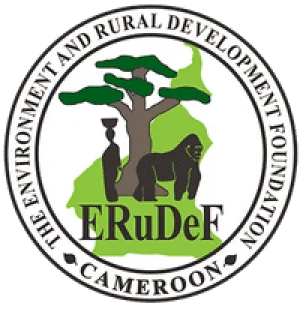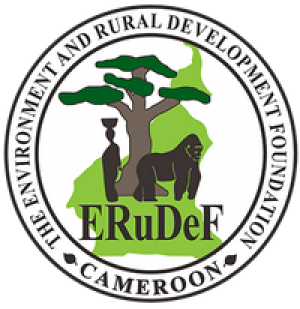Geographic location
The Deng Deng national park – Dja Biosphere Reserve conservation Corridor found in the south eastern part of Cameroon, consists for most part of a series of community forests, Council Forests, production forest, Forest Exploitation or Management Units (FMU) and lesser extent of communal land (belonging to category 2 of state lands). There exist one Technical Operation Units (TOUs) around the Deng Deng National Park and one to be created to the south and enclosing the Dja Reserve. To the north of Dja Reserve, there is Project Grand Singes. A Belgian charity involved in research of great apes in the peripherial zone of Dja Reserve. The corridor encompasses a variety of geographic and climatic zones that contribute to its high biodiversity. The ecology of the target area is enriched with fertile soils which has greatly affected diversity of plants species in the area. Rivers and streams in the park are fed by rainfall and seasonal runoff during the wet season. The vegetation within the area is characterized by dense evergreen and semi-deciduous rainforest (Fotso et al. 2002), consisting of dense with a dark green colour covered by humid tropical trees, mature secondary forest uniformly green, young secondary forest uniformly light green, grassland savanna that are uniformly dense orange and tree savanna which forms a transition between forest and grassland habitat type. This makes the area an important refuge for many animals and plants. However increased exploitation of timber resources is exerting pressure on the area. The area’s relief is mainly flat and consists of a succession of round-topped hills. The main ethnic groups include the Badjoué, Boulou, Fang, Nzimé and two semi nomad groups: the Kakas and the Baka pygmies. Other main economic activities include agriculture, fishery, animal husbandry, hunting, mining and the harvest of plants for domestic or pharmaceutical use.
Social Cultural and Environmental aspects of the Project site.
The Deng Deng-DjaConservation Corridor Project in the East Region of Cameroon occupies the South-Eastern portion of the country and is the largest in terms of area. It is however, the most sparsely populated region in the country with a density of about 7 persons per square km (Diangha, 2005). It covers an area of 109,002 km2 (Statoids 2013) and is bordered by Adamawa region to the North, Center and South Regions to the West, Central African Republic to the East and Congo Brazaville to the south. The region is politically partitioned into four divisions including; Boumba-et-Ngoko, Haut-Nyong, Kadey and Lom-et-Djerem Divisionsthat supports a large stretch of the Cameroon’s lowland rainforest, and humid wooded and grassland savanna ecosystems within its frontiers. The East Region is remote but exceptionally rich in natural resources which have attracted a lot of external actors from logging, bushmeat hunting and harvesting and trade of timber and non-timber forest products (Mertens et al. 2001).Livelihood of the indigenous population in the region, evolved closely with the natural resources within their vicinity. The indigenous population in the villages adjacent to the park belongs to four ethnic groups being Kepere, Bobolis, Pols and Gbaya (ABD 2011, WCS 2010, GVC 2007, Fotso et al. 2002). Among the main ethnic groups in the region, Kepere and Gbaya constitute the highest population and are the most dominant ethnic group. Culture and tradition of the ethnic groups in the region are closely linked with the forest and have since ancient times, regulated their use of natural resources. Recently, people from other ethnic groups including; Bassa, Eton, Kakou, Bavele, Ewondo, Hausa, have migrated to region. Like the indigenous ethnic group, they are also depending on the natural resources within the park and its environ for their livelihood. This region is face with threats that has directly or indirectly cause the reducteof biodiversity in the area.
Factors leading to biodiversity loss in the project area
The presence of porous government of Cameroon forestry and wildlife policies in the region (permission of hotly contested open bush meat markets), Economic Operators and external development bodies such as Cameroon Oil Transportation Company (COTCO) Electricity Development Cooperation (EDC) as well as numerous forestry exploitation companies that allow access to hunting and poaching in the area have together led to an influx of people into the villages within the target area. The increased human population has also led to the high demand for wildlife products in the area thereby promoting illegal hunting and trafficking of ivory. Previously, hunting mainly employed traditional trapping techniques but with the increasing demand for ivory and bush-meat, modern techniques are now being used such as automated guns and rifles for hunting, especially when elephants are targeted to meet the high demand of wildlife products.
The construction of the Lom Pangar Dam has led to the destruction of habitat and an increase in water level. draw fisher men from the North and other neighbouring countries. It also facilitates access to remote areas and increase influx of labour population, hence increases wildlife hunting. The construction of roads by clearing and opening of large forest tracks and construction of settlement camps for workers led to severe biodiversity loss.
The Cameroon railway which pass through the peripheral areas of the Deng Deng National Park-Dja Biosphere Reserve corridor has led to environmental noise, facilitate access to remote areas and also increase transportation of elephant bush meat and ivory to urban markets. Cultivation fields for farmlands by local inhabitants had led to intensive habitat destruction and increase loss of biodiversity.
Grazing in the area is practiced by Fulani pastoralists who always carry out Seasonal burnings for the raring of cattle which causes biodiversity loss and facilitate hunting in exposed area. Fishing activity is mostly carry out by local people in the rivers flowing through the area. Mining operations have led to severe habitat destruction and enormous loss of biodiversity within the target area.
The most significant threat is the increased in fragmentation of the proposed wildlife corridor linking Deng Deng to the Dja Reserve. Without providing a very urgent solution to protecting this corridor, the over 400 western lowland gorillas and greater numbers of other migratory IUCN Red list species (chimps, elephants, etc) would become trapped in the DD NP and would gradually go extinct due to inbreeding
Biodiversity of the project area
The Deng Deng National Park and Dja Biosphere Reserve corridor is a refuge for important fauna community in the East Region. The area is home to at least 40 species of large mammal (Diangha,2015) Among the species, the most northern population of western lowland gorillas inhabit this area and occurs at higher density than in most sites in the East Region of Cameroon (Ambahe et al. 2011). A population survey conducted around the project area revealed that more than 300 western lowland gorillas and 600 chimpanzees live within the National Park (Ambahe et al. 2011, Stautner and Delaney 2011). The area also harbors many water dwelling mammals, hippopotamus and swamp otter which are rare species in Cameroon (Fotso et al. 2002). In addition to mammals, sixty species of fish belonging to 16 families and mostly Mormyridaeand the Cyprinidae are common in the Lom and Pangar Rivers (COTCO 2012). The park host three important birds species namely the African gray parrots, Bates’swaever and Grey- necked rockfowls.The forest flora is however, dominated by commercially valuable Triplochitonscleroxylon, which are heavily targeted for exploitation throughout their range in the east region. Some other important economic plant resources present in the park include; Entandophragmacylindricum, Terminaliasuperba, Entandophragma utile, Erythrophleumsuaveolens, Eribromaoblonga, Guareacedrata, Pterocarpussoyauxii, Xylopiaaethiopica, and Enantiachlorantha.
The biophysical environment of the area is described by its characteristics climate, relief, vegetation types, hydrology with an annual rainfall of 1500 to 1600 mm (COTCO 2011, GVC 2007). The area features a typical equatorial and humid climate (Fotso et al. 2002) defined by the rainfall regime with a mean annual temperature of 23° C. Seasonal pattern in the park area is characterized by distinct but unequal dry and wet season periods.
(COTCO 2011, Fotso et al. 2002). All these features has led to the enriched ecology of the area with diverse animal and plant species.Availability of water in the area is highly influenced by climatic variability and precipitation. Rivers and streams in the park are fed by rainfall and seasonal runoff during the wet season but experience drop in level, decrease in area or go dry during the dry season. Muyual, Mbanpkwa, Mbactoua, Mbibetana are main water sources flowing throughout the year, supplying water to downstream population living around the park. These streams discharge into River Lom, which eventually empty in the Sanaga River
The presence of forest savanna transition zones especially makes the target area flora unique with both savanna and forest species co-existing as the forest transitions into savanna and vice versa. The uniqueness of the flora of the area is further expressed by a small expanse of rock outcrops that support plant species unique to this habitat type.
This makes the area an important refuge for many animals and plants.The project will focus on threatened species such as, the Western Lowland Gorillas(Gorilla gorilla gorilla): Critically Endangered – The western lowland gorillas in the DDNP, numbering 400-600 constitute the most northern range of these gorillas in Cameroon and if not linked to populations further south, this subpopulation may disappear in the longer term from inbreeding, Central Chimpanzees(Pan troglodytes troglodytes): (EN), African Forest Elephants (Loxondontaafricanacyclotis)(Vu), Giant Pangolin (Smutsia gigantea): EN, White bellied Pangolin(Phataginustricuspis): EN, Mandrill (Mandrillus sphinx Vu), Leopard (Pantherapardus): Vu), Sitatunga (Tragelaphusspekii) NT, Bongo (Tragelaphuseurycerus):NT, Forest Buffalo (Synceruscaffer): NT

